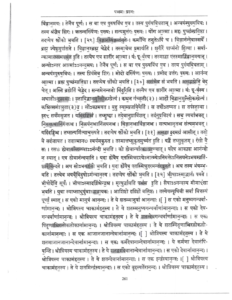Example for यरोऽनुनासिकेऽनुनासिको वा
Today we will look at the application of 8-4-45 यरोऽनुनासिकेऽनुनासिको वा from Bg2-6
न चैतद्विद्मः कतरन्नो गरीयो यद्वा जयेम यदि वा नो जयेयुः ।
यानेव हत्वा न जिजीविषामस्तेऽवस्थिताः प्रमुखे धार्तराष्ट्राः ।।२-६।।
The वृत्तिः for the सूत्रम् 8-4-45 यरोऽनुनासिकेऽनुनासिको वा is from Laghu Siddhanta Kaumudi is यरः पदान्तस्यानुनासिके परेऽनुनासिको वा स्यात्
When a nasal sound follows, then a यर् letter at the end of a पदम् is optionally substituted by a nasal. (Even though the rule is optional, as a convention it is always followed in classical Sanskrit.)
कतरत् + नः । कतरत् gets the पद संज्ञा by 1-4-14 सुप्तिङन्तं पदम्
कतरद् + नः । By 8-2-39 झलां जशोऽन्ते, the letter त् is replaced by द्, which is the closest substitute (1-1-50 स्थानेऽन्तरतमः)
कतरन् + नः । By 8-4-45 यरोऽनुनासिकेऽनुनासिको वा, the letter द् at the end of the पदम् gets replaced by अनुनासिकः optionally, since it is followed by an अनुनासिकः letter. By 1-1-50 स्थानेऽन्तरतमः, the closest substitute has to be chosen. द् and न् share a common place of articulation (दन्ताः) and same internal effort (स्पृष्टम्) So, न् is the closest substitute.
So, we get two final forms कदरद् नः and कतरन्नः
Questions:
1. Perform सन्धिः between the words अकृतबुद्धित्वात् + न (Bg18-16)
2. Why did we have to apply 8-2-39 झलां जशोऽन्ते even though applying 8-4-45 यरोऽनुनासिकेऽनुनासिको वा directly on the initial letter त् would have given the same result?
3. Under 8-4-45 यरोऽनुनासिकेऽनुनासिको वा, the Siddhanta Kaumudi says स्थानप्रयत्नाभ्यामन्तरतमे स्पर्शे चरितार्थो विधिरयं रेफे न प्रवर्तते । चतुर्मुखः Please explain
4. Further under 8-4-45 यरोऽनुनासिकेऽनुनासिको वा, the Siddhanta Kaumudi says कथं तर्हि “महोदग्राः ककुद्मन्तः” इति? यवादिगणे दकारनिपातनात् Please explain
Example for 8-4-40 स्तोः श्चुना श्चुः
Today we will look at the application of 8-4-40 स्तोः श्चुना श्चुः।
The वृत्तिः from Laghu Siddhanta Kaumudi is सकारतवर्गयोः शकारचवर्गाभ्यां योगे शकारचवर्गौ स्तः
When the letter ‘स्’ or a letter of the त-वर्ग: (‘त्’, ‘थ्’, ‘द्’, ‘ध्’, ‘न्’) comes in contact with either the letter ‘श्’ or a letter of the च-वर्ग: (‘च्’, ‘छ्’, ‘ज्’, ‘झ्’, ‘ञ्’), then it is replaced respectively by ‘श्’, च-वर्ग: (‘च्’, ‘छ्’, ‘ज्’, ‘झ्’, ‘ञ्’)।
Example 1 Bg1-36
निहत्य धार्तराष्ट्रान्नः का प्रीतिः स्याज्जनार्दन ।
पापमेवाश्रयेदस्मान्हत्वैतानाततायिनः ।।
स्यात् + जनार्दन ।
= स्याद् + जनार्दन । By 8-2-39 झलां जशोऽन्ते ।
= स्याज् + जनार्दन । 8-4-40 स्तोः श्चुना श्चुः
= स्याज्जनार्दन
Example 2 Bg9-19
तपाम्यहमहं वर्षं निगृह्णाम्युत्सृजामि च ।
अमृतं चैव मृत्युश्च सदसच्चाहमर्जुन ।।
असत् + च ।
= असद् + च । By 8-2-39 झलां जशोऽन्ते ।
= असज् + च । 8-4-40 स्तोः श्चुना श्चुः ।
= असच्च । By 8-4-55 खरि च ।
Questions:
1. Is 8-4-40 स्तोः श्चुना श्चुः applied anywhere in the following verse Bg5-1?
संन्यासं कर्मणां कृष्ण पुनर्योगं च शंससि ।
यच्छ्रेय ऐतयोरेकं तन्मे ब्रूहि सुनिश्चितम् ।।
2. As per the rules of grammar, is the application of the सूत्रम् 8-4-40 स्तोः श्चुना श्चुः valid in the examples below? Why or why not?
समश्ञुते ।
अनुप्रश्ञाः।
These are taken from the Taittiriya Upanishad passage below. (pdf for clarity).

Recent Comments